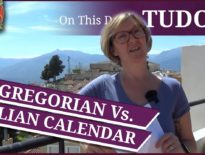On this day in Tudor history, 11th April 1533, Good Friday, King Henry VIII informed his council that Anne Boleyn, the woman he'd married in January 1533, was his rightful wife and queen, and should be accorded royal honours.
Finally, things were going right for the couple, who had been waiting for this moment since 1527.
Find out more about what had led Henry VIII and Anne Boleyn to this point, and why they thought that the Great Matter would be sorted out much quicker, in today's talk.
You can see the painting, The Ambassadors at https://www.nationalgallery.org.uk/paintings/hans-holbein-the-younger-the-ambassadors
Also on this day in Tudor history, 11th April 1534, Sir Thomas Wyatt the Younger was beheaded for treason. Why? What had led him to this sticky end? Find out in last year's video:
Series of articles on Holbein's The Ambassadors:
- https://www.theanneboleynfiles.com/holbeins-the-ambassadors-a-renaissance-puzzle-part-one-context/6516/
- https://www.theanneboleynfiles.com/holbeins-the-ambassadors-a-renaissance-puzzle-part-two-symbols/6532/
- https://www.theanneboleynfiles.com/holbeins-the-ambassadors-a-renaissance-puzzle-part-three-jupiter-and-change/6600/
Also on this day in history:
- 1492 – Birth of Marguerite de Navarre (also known as Marguerite of Angoulême and Marguerite de France), sister of Francis I of France, daughter of Louise of Savoy and Charles, Count of Angoulême, and author of "Miroir de l'âme pécheresse".
- 1548 – Death of Sir John Welsbourne, Gentleman of the Privy Chamber to Henry VIII and Justice of the Peace.
- 1609 – Death of John Lumley, 1st Baron Lumley, conspirator (Ridolfi Plot, patron and collector. His library was said to be one of the largest in England, and he collected manuscripts, books, paintings, sculptures, marble busts and furniture. Lumley was buried at night, probably so that he could be buried with a Catholic service, in the Lumley Chapel of St Dunstan's in Cheam.
Transcript:
On this day in Tudor history, 11th April 1533, Good Friday, informed his Council that Anne was his rightful wife and Queen and that she should be accorded with royal honours. The following day, the pregnant Anne Boleyn attended Holy Saturday mass “with all the pomp of a Queen, clad in cloth of gold, and loaded (carga) with the richest jewels.” A real statement!
While the king was ordering his council to do this, his new Archbishop of Canterbury, Thomas Cranmer, was working on the king’s “Great Matter”, i.e. the annulment of Henry VIII’s marriage to Catherine of Aragon.
Being recognised as queen and appearing in public as queen was a huge deal for Anne, who’d been waiting to be Henry VIII’s wife and queen since his proposal in 1527. Neither of them could have known that it would take that long to get the marriage annulled. Why do I say that? Well, because Henry VIII wasn’t actually asking the Pope for anything unusual. In the 12th century, Louis VII of France had asked for his marriage to Eleanor of Aquitaine, which had produced only daughters and no make heir, to be annulled and the annulment had been granted. In more recent history, Louix XII had has his marriage to Joan of France annulled by the pope so that he could marry Anne of Brittany. Things were different in Henry VIII’s case though. Although he and his canon lawyers could argue that the dispensation that Pope Julius II was not valid because the pope should not overturn God’s law, Henry’s wife, Catherine of Aragon, was opposed to the annulment and had appealed to the pope and to her nephew, Charles V, Holy Roman Emperor. Pope Clement VII could not afford to upset the powerful Holy Roman Emperor.
In 1529 a special legatine court opened at Blackfriars in London. The court’s purpose was to hear the case for the annulment. It was presided over by papal legate Cardinal Lorenzo Campeggio and Cardinal Thomas Wolsey, who had been made Pope Clement VII’s viceregent in 1528 “to take cognisance of all matters concerning the King’s divorce”. Unfortunately, the court was adjourned in July 1529 for a summer recess, but never reopened as Catherine appealed her case directly to Rome. Henry VIII was bitterly disappointed. His disappointment with his advisor, Cardinal Wolsey, made the cardinal vulnerable and his enemies were able to paint him who was stalling over the annulment and who was in the pocket of France, and not working for the king’s best interests. He was called to London to face charges of praemunire, but died on the way.
In 1531, with the help of his new right-hand man, Thomas Cromwell, Henry was granted the title of “singular protector, supreme lord, and even, so far as the law of Christ allows, supreme head of the English church and clergy”, and in 1532 Anne Boleyn was raised to the peerage, being made Marquess of Pembroke in her own right. The couple then had a successful trip to Calais, gaining Francis I’s support for their plans to marry, and they may even have married in secret on their arrival back in England on 14th November 1532.
On 25th January 1533, they had a secret but official marriage ceremony at Whitehall Palace. Although they may not have known at the time, Anne was pregnant.
On 30th March 1533, Thomas Cranmer was consecrated as Archbishop of Canterbury and on 5th April 1533, convocation determined that the pope was wrong in issuing a dispensation for Henry VIII to marry Catherine of Aragon, his brother’s widow. On 9th April, Catherine was informed that she was demoted from queen to Dowager Princess of Wales and on this day in 1533, Henry VIII informed his Council that Anne was his rightful wife and Queen and that she should be accorded with royal honours.
On 23rd May 1533, a special court annulled Henry VIII’s marriage to Catherine and on 28th May, the Archbishop of Canterbury proclaimed that Henry’s second marriage was valid. Victory at last for the king and Anne Boleyn, and they set about celebrating it in style with a lavish coronation at Westminster Abbey, which followed three days of pageantry, processions and celebrations. At least six years of waiting, then victory, and then just three short years as queen. It’s so very sad.
I’ll give you a link to a timeline I made of Henry and Anne’s relationship from 1528 to 1533, so you can see the main events.
By the way, the 11th April 1533, the date when Anne Boleyn was officially recognised as Queen, is recorded in the amazing painting by Hans Holbein the Younger, The Ambassadors, which portrays two ambassadors: Jean de Dinteville, maître d’hôtel to Francis I of France, and George de Selve, Bishop of Lavaur. Those who have analysed the painting have found the date marked on the celestial globe, the quadrant and the cylinder sundial. Historian Eric Ives wonders if this spectacular painting was actually commissioned by Anne Boleyn. It is an amazing painting which is rich in symbolism and messages, and I’ll give you links to my series of three articles on it.
Interestingly, in May 1536, ambassador Jean de Dinteville attempted to intercede on behalf of Sir Francis Weston, who was accused of sleeping with Queen Anne Boleyn, but his petition was unsuccessful.



Serendipity came into force today, as I was reading about the wedding of Anne and Henry only this morning in your book on George Boleyn. What a shame that George couldn’t attend this much waited for marriage. Really enjoyed this video, Claire.